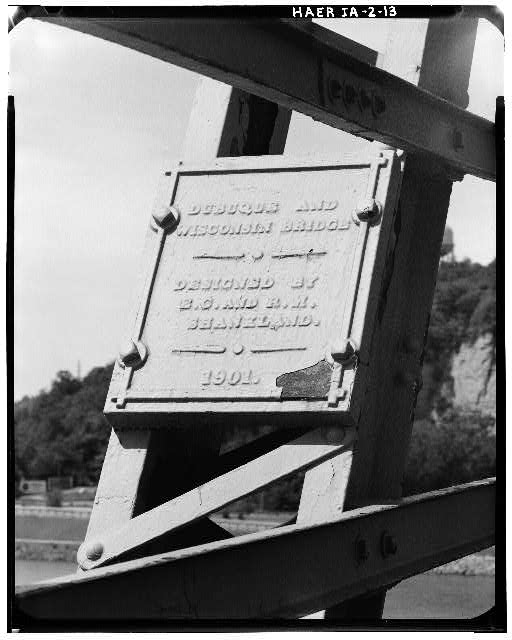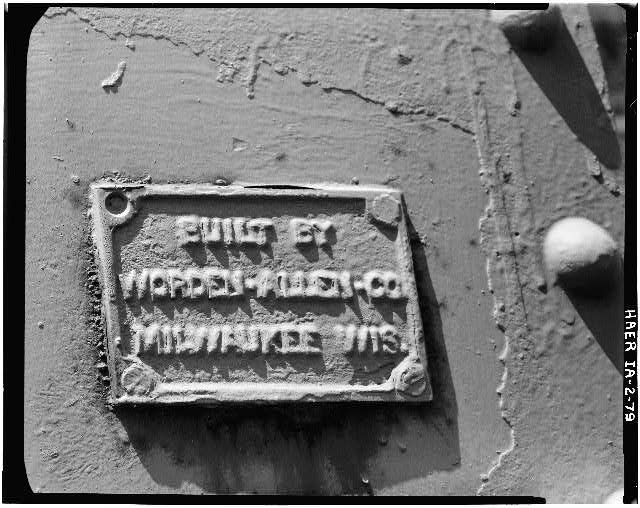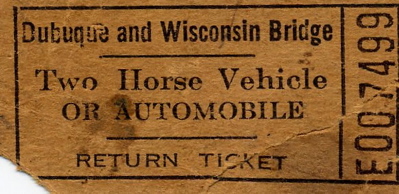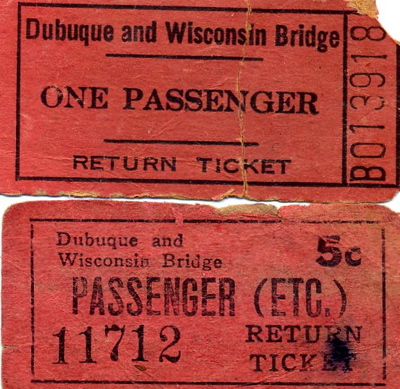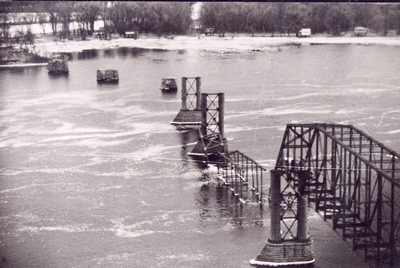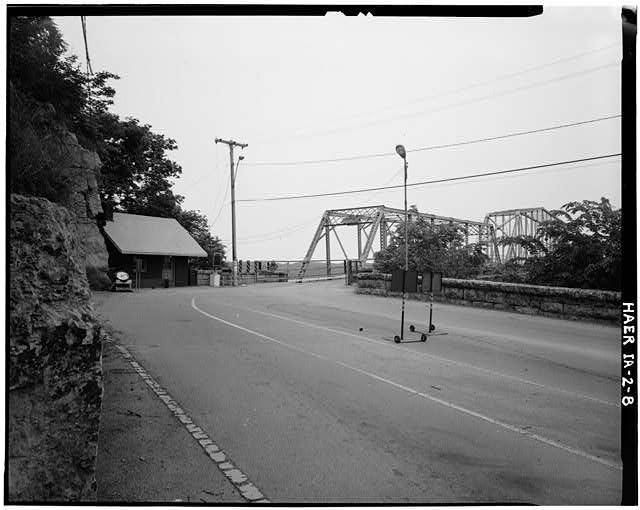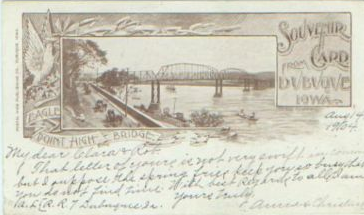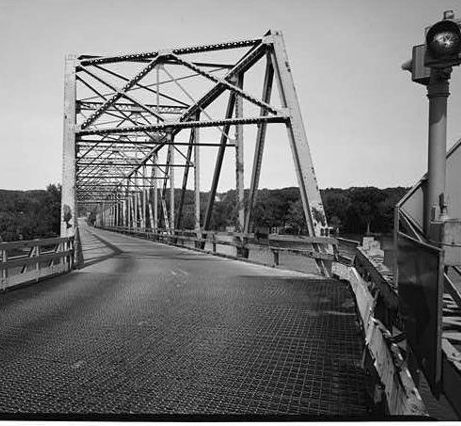Encyclopedia Dubuque
"Encyclopedia Dubuque is the online authority for all things Dubuque, written by the people who know the city best.”
Marshall Cohen—researcher and producer, CNN
Affiliated with the Local History Network of the State Historical Society of Iowa, and the Iowa Museum Association.
EAGLE POINT BRIDGE
EAGLE POINT BRIDGE. In 1894 Joseph A. RHOMBERG organized the DUBUQUE AND WISCONSIN BRIDGE COMPANY.
Articles of incorporation filed on May 30, 1894 called for the project to be capitalized at $100,000. The board of directors included M. Kirkberg, Jamestown, Wisconsin; George Kieler, Kieler, Wisconsin; John Langbotham, Dickeyville, Wisconsin; Joseph A Rhomberg; George FENGLER; Paul TRAUT; S. D. Ryan, ; Marshall M. WALKER; John Morrison, and Adam Francis JAEGER, Jr.. (1)
So confident were the investors that the first money was solicited in 1894. By August, company officials together with members of the DUBUQUE TRAVELING AND BUSINESS MEN'S ASSOCIATION had gathered $15,000 in subscriptions from farmers in Wisconsin. (2) They were able to state that the project was already a financial success before beginning the subscription program on the Iowa side. (3)
Despite the fact that it was felt a new bridge would encourage traffic into Dubuque from an area not then being served, it seemed a bad time to consider a new bridge. (4) In 1894, the company operating the Wagon Bridge petitioned the city council, due to its lack of revenue, to cancel the 1893 tax due to the city. The charter of the company stated the bridge would not be taxed any year it did not generate 8% interest on the capital invested. (5) Interest was sparked in having the city take over the bridge and making its use free.
Citizens in the Fifth Ward were not opposed to the Wagon Bridge being made free, but they wanted one built in their part of the city. The proposal before the city council to take over the bridge looked to them as an attempt by the "lower end of town" and the DUBUQUE HIGH BRIDGE COMPANY to have a free bridge while preventing them from having any bridge. (6) There was a provision that the city would not aid in the construction of another bridge until the Wagon Bridge was fully paid. (7) The issue was settled on February 4, 1895 when the city council rejected the Wagon Bridge proposal which had meant taking over the bridge, keeping it in repair, and paying 8% to the stockholders forever. (8)
Joseph A. Rhomberg met with the Dubuque city council and stated that there were 250 people willing to contribute to the construction. He proposed that masonry piers would be set three to four feet above the high water mark with all construction above this in steel. Completion of the bride was estimated to be six months at a cost of between $120,000 and $140,000. (9)
Despite the council's passage of a resolution that it was not bound in any manner to aid in the construction of a new bridge until the Wagon Bridge had been purchased by the city, the matter was reintroduced on August 16, 1895. A petition from the DUBUQUE AND WISCONSIN BRIDGE COMPANY was read to the council asking for $25,000 "contributed on substantially the same terms and conditions as the former appropriation in aid of the high bridge between the city and East Dubuque." The money was to be used for the construction of bridge approaches in Iowa. (10)
On October 5, 1895 the city council met to consider the request for $25,000. The council responded by stipulating that the money would be provided, as it had been for the WAGON BRIDGE, if the city had the right to purchase at cost, minus the $25,000, and 8% interest the bridge unless the company later returned the $25,000. (11) When the company had achieved all the money necessary for the project, the Dubuque city council awarded $25,000 as a bonus. (12)
Plans were changed. In 1899 E. R. Shankland, a civil engineer and contractor who worked on the Chicago World's Fair, arrived in Dubuque and decided to move the location of the bridge six hundred feet north of the original proposal. (13) The river commission in 1900 decided that the three spans would each need to be 350 feet wide. Shankland redraw plans on submit them to an engineer in Rock Island for approval. (14) In 1900 Senator William Boyd ALLISON introduced the necessary bill in Congress stating that the bridge would be constructed near EAGLE POINT and that it would not be constructed within two miles of any other bridge. Directions for construction would be a responsibility of the Secretary of War and work was to be completed within three years of the passage of the bill. (15)
The company directors continued to hope that construction starting with bridge piers could be completed by the time the river froze. (16) Almost immediately, however, unforeseen obstacles arose. When the site was mapped, engineers did not expect to find any rock. They were surprised when driving the first piles for the piers to encounter a 56 x 24 foot rock six feet below the river bottom. (17) This necessitated the construction of a coffer dam by the firm of LINEHAN & MOLO which had the contract for driving piles and constructing bridge piers. (18)
The western approach to the bridge also caused problems. The route affected the Fengler property, a piece of ground 600 feet long and fifty feet wide. To determine an evaluation, a jury was formed to reach a decision. (19) The eastern portion of the bridge was made of wood instead of the iron used on the western side. The bend in the bridge near the Wisconsin side was used to save additional money. The 1,100 foot-long bridge stretched from Eagle Point into an area in Wisconsin formerly known as Kimbel's Slough or KIMBEL PARK over an additional 1,800 feet of trestle. This trestle ran over land except during high water when the slough area flooded.
The opening of the bridge was not celebrated as might have been expected. Bridge company officials chose not to invest their money in a ceremony. (20) No reason was given for the fact that the Dubuque Retailer Association abandoned its plans for a celebration.
Pedestrian crossings costing five cents began on May 3rd although the bridge was not opened for teams of horses until May 6, 1902. Mrs. George Gantenbein was the first to pay the twenty-five cent toll to drive a team of horses with a load of produce to the Central Market.
Although organized celebrations failed, the opening of the bridge did create local interest. On May 18,1902 an estimated five thousand people crossed the new bridge in a celebration planned by the DUBUQUE SAENGERBUND. The fraternal organization announced May 18th as the day for Dubuque residents to cross the bridge into Wisconsin for a day of beer drinking and dancing at Kimball's Park.
Toll takers working for the Dubuque-Wisconsin Bridge Company worked twelve hour split shifts.
In 1922 the eastern approach to the Eagle Point high bridge was renovated. Structural steel replaced the wooden structure at a cost of $25,000. Work was done so that traffic moving in either direction was not affected. (21) Painting the bridge in 1926 took over four hundred gallons of paint with the most difficult part being the inverted fifth span. (22) The inverted span, according to the bridge company, was used to save money while providing the same structural support. (23) In 1928 the wooden joists of the bridge were replaced with steel girders and the floor was replaced. With the steel girders, the carrying weight of the bridge increased to twenty tons. The new flooring was composed of creosoted wooden planks covered with tarvia and stone. (24)
Construction continued in 1935. As originally planned, a new roadway to the eastern side of the bridge was planned 600 feet south of the highway that then connected the roadway to Wisconsin Highway 61. The plan was dropped due to its cost. Excavation began on the island just west of the Wisconsin shore known officially as "Island 27" on government engineer's maps and locally as "Squatter's Island" or "Lenstra's Island." Thirty summer cottages located on it had to be removed. The sharp bend in the bridge was removed so that the bridge was nearly a straight line from shore to shore. While work was underway, a wooden trestle was used so that traffic was never halted. (25)
In 1946 the creosoted wooden planks were replaced with an open steel grid. This offered the advantage of allowing rain or melting snow to fall into the river rather than pool and possibly freeze on the bridge surface. (26)
Semi-trucks were banned from using the bridge in 1967. The use of the bridge was reduced in 1969 when both the Iowa and Wisconsin departments of transportation removed the bridge from highway designations. U. S. 151 and 61 were routed to the JULIEN DUBUQUE BRIDGE and weight limits were imposed on the Eagle Point Bridge. Despite this, between three thousand and four thousand vehicles continued to use it daily, many drivers heading for the JOHN DEERE DUBUQUE WORKS north of the city. (27)
Congestion on the bridge led to a proposal in 1974. The DUBUQUE AND WISCONSIN BRIDGE COMPANY suggested a plan to add a second toll booth and widen the access on the Iowa side. Traffic into Dubuque from Wisconsin used two lanes and both toll booths in the morning. Traffic to Wisconsin used one lane and one booth. The pattern was reversed at night. (28)
In 1958, ownership of the bridge was held by 212 stockholders who were mostly descendants of the original investors. (29) In 1979 when the bridge was purchased by the State of Iowa for $769,700, part-time help was hired; shifts ran eight hours long. The state paid overtime to the toll-takers and paid extra for working on holidays. While the bridge company paid neither of these benefits, employees usually received a Christmas bonus of several hundred dollars something not paid by the state. During the first eight months the state owned the bridge, it took in $272,000 against expenses of $66,673. Tolls at this time were: (30)
30 cents for a single occupant vehicle
45 cents for a vehicle carrying one or more additional people
60 cents for a vehicle towing a trailer
In 1982, despite suggestions that the bridge be kept open for pedestrian and bicycle traffic and an inspection showing the bridge was structurally and functionally sound, the span was demolished at a cost of $500,000. (31) Iowa officials explained that the federal government which was paying for the new DUBUQUE-WISCONSIN BRIDGE would not allow the old bridge to remain. (32) Profits from tolls were used to help pay the cost of demolition. (33) Rumors that the owners would sue to block construction of a new bridge across the river were denied.
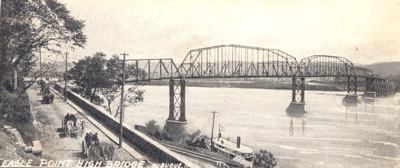
See: DUBUQUE PONTOON BRIDGE COMPANY
---
Source:
1. "The Eagle Point Bridge," Dubuque Daily Herald, May 30, 1894, p. 4.
2. "Credit Where Due," Dubuque Daily Telegraph, April 7, 1901, p. 6. Online: http://news.google.com/newspapers?id=kDdBAAAAIBAJ&sjid=y6gMAAAAIBAJ&pg=2908,1897904&dq=eagle+point+bridge&hl=en
3. "Eagle Point Bridge," Dubuque Daily Herald, August 11, 1899, p. 8. Online: http://news.google.com/newspapers?id=bwhBAAAAIBAJ&sjid=OagMAAAAIBAJ&pg=2078,4934833&dq=eagle+point+bridge&hl=en
4. "Will Aid Dubuque," Dubuque Daily Herald, May 19, 1894, p. 4. Online: https://news.google.com/newspapers?nid=_OG5zn83XeQC&dat=18940519&printsec=frontpage&hl=en
5. "Postponed for Two Weeks," Dubuque Daily Herald, June 5, 1894, p. 4
6. "Trouble Brewing," Dubuque Daily Herald, February 1, 1895, p. 8. Online: https://news.google.com/newspapers?nid=_OG5zn83XeQC&dat=18950201&printsec=frontpage&hl=en
7. "No Powder Left," Dubuque Daily Herald, February 3, 1895, p. 4. Online: https://news.google.com/newspapers?nid=_OG5zn83XeQC&dat=18950203&printsec=frontpage&hl=en
8. "Shea's Surprise," Dubuque Daily Herald, February 5, 1895, p. 8, 1895, Online: https://news.google.com/newspapers?nid=_OG5zn83XeQC&dat=18950205&printsec=frontpage&hl=en
9. "Eagle Point Bridge," Dubuque Daily Herald, October 6, 1895, p. 4. Online: https://news.google.com/newspapers?nid=_OG5zn83XeQC&dat=18951006&printsec=frontpage&hl=en
10. "Same Old Ghost," Dubuque Daily Herald, August 17, 1895, p. 8. Online: https://news.google.com/newspapers?nid=_OG5zn83XeQC&dat=18950817&printsec=frontpage&hl=en
11. "Want That Bridge," Dubuque Daily Herald, October 5, 1895, p. 8. Online: https://news.google.com/newspapers?nid=_OG5zn83XeQC&dat=18951005&printsec=frontpage&hl=en
12. "They Vote $25,000," Dubuque Daily Herald, November 5, 1895, p. 8. Online: http://news.google.com/newspapers?id=qrBFAAAAIBAJ&sjid=LL0MAAAAIBAJ&pg=3137,6288801&dq=eagle+point+bridge&hl=en
13. "Eagle Point Bridge," August 11, 1899"
14. "Eagle Point Bridge, Dubuque Daily Herald, June 14, 1900, p. 8. Online: http://news.google.com/newspapers?id=XyNBAAAAIBAJ&sjid=kagMAAAAIBAJ&pg=2229,991149&dq=eagle+point+bridge&hl=en
15. "Eagle Point Bridge," Dubuque Daily Herald, January 19, 1900, p. 8. Online: http://news.google.com/newspapers?id=RhhBAAAAIBAJ&sjid=cKgMAAAAIBAJ&pg=3001,7141367&dq=eagle+point+bridge&hl=en
16. "The New Bridge," Dubuque Daily Telegraph, August 4, 1901, p. 8
17. Ibid.
18. "Is Ready to Begin," Dubuque Daily Telegraph, June 2, 1901, p. 2
19. "Bridge Approach," Dubuque Telegraph-Herald, October 30, 1901, p. 3
20. "Big Celebration," Dubuque Telegraph Herald, March 15, 1902, p. 3. Online: http://news.google.com/newspapers?id=bWhBAAAAIBAJ&sjid=MqkMAAAAIBAJ&pg=5026,33516&dq=eagle+point+bridge&hl=en
21. "Push Eagle Point Bridge Project," Telegraph Herald, Sept. 10, 1922, p. 1. Online: http://news.google.com/newspapers?id=xahjAAAAIBAJ&sjid=js0MAAAAIBAJ&pg=4652,109136&dq=eagle+point+bridge&hl=en
22. "Work on Eagle Point Bridge Nearing Completion," Telegraph Herald, October 10, 1926, p. 2. Online: http://news.google.com/newspapers?id=BDVFAAAAIBAJ&sjid=krsMAAAAIBAJ&pg=3294,5681095&dq=eagle+point+bridge&hl=en
23. Bulkley, John. "Iowa Bidding for Eagle Point Bridge," Telegraph Herald, February 7, 1979, p. 1. Online: http://news.google.com/newspapers?id=D9hBAAAAIBAJ&sjid=LqoMAAAAIBAJ&pg=6949,932970&dq=eagle+point+bridge&hl=en
24. "Eagle Point Bridge to Get Improvements," Telegraph Herald and Times Journal, December 17, 1928, p. 2. Online: http://news.google.com/newspapers?id=godFAAAAIBAJ&sjid=pbwMAAAAIBAJ&pg=4051,285914&dq=eagle+point+bridge&hl=en
25. "Part of Eagle Point Bridge to be Rebuilt," Telegraph Herald, August 4, 1935, p. 23. Online: http://news.google.com/newspapers?id=TLxBAAAAIBAJ&sjid=tqkMAAAAIBAJ&pg=7192,3340237&dq=eagle+point+bridge&hl=en
26. Penman, Janice. "That Upside Down Span," Telegraph Herald, July 6, 1958, p. 10
27. Kelly, Steve and Kircher, Steve. "Bridge Repairs Exact Toll in Downtown Traffic," Telegraph Herald, May 22, 1979, p. 1. Online: http://news.google.com/newspapers?id=M-5BAAAAIBAJ&sjid=PqoMAAAAIBAJ&pg=4513,3177103&dq=eagle+point+bridge&hl=en
28. "Second Toll Booth and Extra Lane Proposed for Eagle Point Bridge," Telegraph Herald, October 17, 1974, p. 11. Online: http://news.google.com/newspapers?id=-gVRAAAAIBAJ&sjid=Gr8MAAAAIBAJ&pg=7238,4078241&dq=eagle+point+bridge&hl=en
29. Penman
30. Bulkley, John. "Iowa Votes to Buy Point Bridge for $769,700, Telegraph Herald, March 20, 1979, p. 1. Online: http://news.google.com/newspapers?id=hPhBAAAAIBAJ&sjid=R6oMAAAAIBAJ&pg=2059,2384459&dq=eagle+point+bridge&hl=en
31. "Contract Awarded for Demolition of Eagle Point Bridge," Telegraph Herald, July 11, 1982, p. 4. Online: http://news.google.com/newspapers?id=HJFSAAAAIBAJ&sjid=wNAMAAAAIBAJ&pg=6728,1212934&dq=eagle+point+bridge&hl=en
32. Ibid.
33. Bigelow, Bruce."Bridge Tolls to Pay for Dismantlement," Telegraph Herald, February 21, 1980, p. 11. Online: http://news.google.com/newspapers?id=SOlFAAAAIBAJ&sjid=XwUNAAAAIBAJ&pg=5826,2846344&dq=eagle+point+bridge&hl=en





